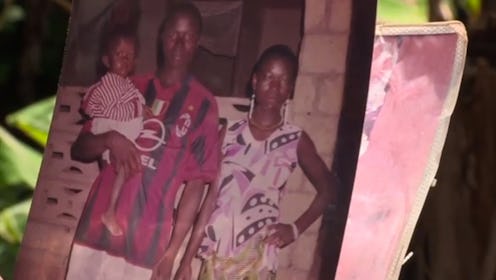News
Meet Ebola's 2-Year-Old "Patient Zero"

If you're an American infected with the Ebola virus, things have been looking slightly more hopeful recently. Tuesday brought some unexpectedly uplifting news on this front, as Dallas-area nurse Amber Vinson has been declared free of Ebola. Vinson is the second person who's survived infection from the late Thomas Eric Duncan, who died of the virus Oct. 8. But as citizens of a relatively well-off country, it's worth remembering not everyone has it so lucky. For example, take the first victim of Ebola in West Africa, Emile Ouamouno, a 2-year-old toddler whose death in December 2013 preceded this year's horrific spread of the virus throughout Guinea, Liberia, and Sierra Leone. Singled out by researchers from The New England Journal of Medicine, Emile is considered the so-called "patient zero" of this current outbreak, and as such, it's worth spending a few moments on his memory.
The story is a grisly and tragic one, made all the more sad by the memories of the young boy's parents. As expertly detailed by Suzanne Beukes of the Daily Maverick, a South African newspaper, the outbreak's point of origin is believed to be the otherwise low-profile village of Meliandou, in southern Guinea. It's not understood how the child contracted Ebola, though animals are frequently identified as major potential culprits — as the World Health Organization (WHO) states, "infection has been documented through the handling of infected chimpanzees, gorillas, fruit bats, monkeys, forest antelope and porcupines."
Beukes spoke with Emile's father, Etienne, while visiting Meliandou, and she paints a heartbreaking picture — after his young son died from Ebola on December 6, the child's mother, grandmother, and sister also contracted and died from the hemorrhagic fever within a month. In other words, Etienne went from a full family life, even living in an impoverished village in West Africa, to the survivor of a horrifying viral outbreak to which he lost his loved ones. Beukes described his stricken, disbelieving grief nearly 10 months later.
Visibly shocked and still grieving, he sorts through a pile of old photographs to show me what the world’s most infamous unnamed toddler looked like when he was a few days old – a bundle of blankets surrounding a precious face held by two awkward young parents. Etienne turns on a bright red portable radio, which contrasts starkly with the muddy colour of the two-roomed house. “Emile liked to listen to the radio, and his sister liked to carry babies on her back,” he explains.
As CNN notes, Meliandou sits close to Guinea's borders with both Sierra Leone and Liberia, which could explain how the virus spread into all three countries in such dramatic fashion. According to data from the Centers for Disease Control (CDC), Guinea has seen 1,553 infections since the outbreak began, and 926 deaths — the lowest for any of the three worst-hit nations, but those figures are still dizzyingly awful.
After Emile's death, the village reportedly lost 14 more people to Ebola, including Emile's aforementioned family members. And although Meliandou is now free from Ebola, the infamy the village now holds has hurt the local economy — very bad news, considering it wasn't well-off to begin with. The village's chief, Amadou Kamano, described the impact that fear has had on his home to UNICEF:
Nobody wants to buy our products. People burnt everything out of fear … now we are even poorer than we were before.
So, in short, the next time you feel a pang of unease about Ebola's incursion into the United States, bear these two things in mind: Yes, Ebola is awful, and it's important to halt it in its tracks. But also, be thankful that we live where we do, and actually have the resources and technology to help make that a reality. After all, for thousands of people across West Africa, like Emile Ouamouno, things aren't so fortunate.
Images: UNICEF/YouTube (2)